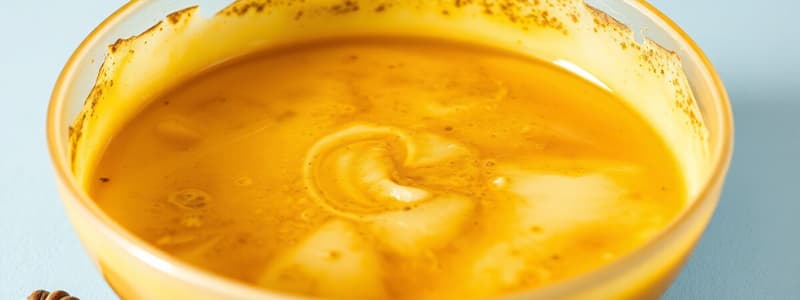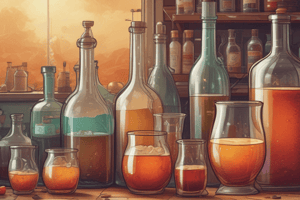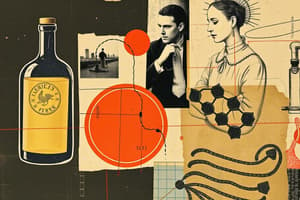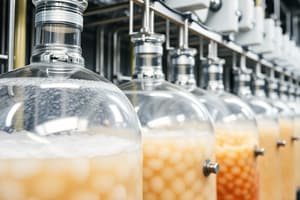Podcast
Questions and Answers
What is the key process that yeasts perform to produce ethanol?
What is the key process that yeasts perform to produce ethanol?
- Oxidation
- Fermentation (correct)
- Distillation
- Replication
The earliest evidence of humans making alcoholic beverages dates back to 7000 BCE in Egypt.
The earliest evidence of humans making alcoholic beverages dates back to 7000 BCE in Egypt.
False (B)
What is the upper limit to the percentage of alcohol that can be achieved through natural fermentation?
What is the upper limit to the percentage of alcohol that can be achieved through natural fermentation?
13%
The process of __________ involves boiling fermented liquids to vaporize and collect alcohol, resulting in a more concentrated product.
The process of __________ involves boiling fermented liquids to vaporize and collect alcohol, resulting in a more concentrated product.
Match the region with its traditionally made alcoholic beverage:
Match the region with its traditionally made alcoholic beverage:
Why was wine more readily available in ancient Greece and Rome compared to ancient Mesopotamia and Egypt?
Why was wine more readily available in ancient Greece and Rome compared to ancient Mesopotamia and Egypt?
Ancient Mesopotamians and Egyptians primarily produced wine due to the favorable climate for grape cultivation.
Ancient Mesopotamians and Egyptians primarily produced wine due to the favorable climate for grape cultivation.
What preservative property of alcohol made it useful for long sea voyages?
What preservative property of alcohol made it useful for long sea voyages?
During the Age of Exploration, __________ made from sugar became a staple for sailors and was traded extensively.
During the Age of Exploration, __________ made from sugar became a staple for sailors and was traded extensively.
Match the historical perspective on alcohol consumption with its origin:
Match the historical perspective on alcohol consumption with its origin:
Which of the following best describes the initial use of distilled spirits in the 9th century?
Which of the following best describes the initial use of distilled spirits in the 9th century?
The Islamic rule against praying while drunk led to the instant and universal adoption of a total ban on alcohol consumption in all Islamic regions.
The Islamic rule against praying while drunk led to the instant and universal adoption of a total ban on alcohol consumption in all Islamic regions.
What was the role of spirits in the trade between Europe and Africa during the Age of Exploration?
What was the role of spirits in the trade between Europe and Africa during the Age of Exploration?
Yeasts produce __________ as they metabolize sugars in overripe fruit, leading to the creation of alcoholic beverages.
Yeasts produce __________ as they metabolize sugars in overripe fruit, leading to the creation of alcoholic beverages.
Match the type of alcohol with its source during ancient times:
Match the type of alcohol with its source during ancient times:
Which event directly enabled the creation of alcoholic beverages with alcohol content higher than 13%?
Which event directly enabled the creation of alcoholic beverages with alcohol content higher than 13%?
Adding brandy to water barrels on long sea voyages primarily served to improve the taste of the water.
Adding brandy to water barrels on long sea voyages primarily served to improve the taste of the water.
Besides its health benefits, what creative benefit did Greek poets attribute to wine?
Besides its health benefits, what creative benefit did Greek poets attribute to wine?
The incident involving a chimpanzee consuming overripe plums illustrates the natural occurrence of __________ when fruit sugars are converted to ethanol.
The incident involving a chimpanzee consuming overripe plums illustrates the natural occurrence of __________ when fruit sugars are converted to ethanol.
Match each region with the primary crop used to create alcoholic beverages:
Match each region with the primary crop used to create alcoholic beverages:
Flashcards
Yeasts
Yeasts
Microscopic organisms that feed on sugars, producing ethanol. They are key to fermentation.
Fermentation
Fermentation
A process where yeasts consume sugars in fruits or grains, producing ethanol (alcohol).
Early Alcoholic Beverage
Early Alcoholic Beverage
A drink made from fermented rice, millet, grapes, and honey, dating back to 7000 BCE in China.
Ancient Beer
Ancient Beer
Signup and view all the flashcards
Distillation
Distillation
Signup and view all the flashcards
Alcohol's Boiling Point
Alcohol's Boiling Point
Signup and view all the flashcards
Spirits in Trade
Spirits in Trade
Signup and view all the flashcards
Alcohol as a Preservative
Alcohol as a Preservative
Signup and view all the flashcards
Study Notes
- Chimpanzees can stumble upon overripe plums and experience strange effects due to the fermentation process.
- Sugars in overripe fruit attract yeasts, which produce ethanol (alcohol) through fermentation.
Early Fermented Beverages
- The earliest evidence of humans creating alcoholic beverages dates back to 7000 BCE in China.
- Residue in clay pots indicates the use of fermented rice, millet, grapes, and honey.
- Ancient Mesopotamians and Egyptians produced beer from stored cereal grains.
- Beer was a common beverage for all social classes and was included in workers' daily rations.
- Wine was also made but was a rare and expensive delicacy due to the climate.
- In Greece and Rome, wine was readily available due to favorable grape-growing conditions.
- Ancient peoples made alcohol from locally grown crops and plants.
- South Americans made chicha from grains, sometimes adding hallucinogenic herbs.
- In Mexico, pulque, made from cactus sap, was a popular drink.
- East Africans made banana and palm beer.
- In Japan, sake was made from rice.
Societal Views on Alcohol
- As alcohol consumption became widespread, authorities had mixed views.
- Greek physicians considered wine to be good for health, while poets saw it as a creative aid.
- Greek philosophers promoted temperance.
- Early Jewish and Christian writers integrated wine into rituals but viewed excessive intoxication as a sin.
- Islamic cultures in the Middle East, Africa, and Spain eventually banned alcohol due to concerns about praying while drunk.
Distillation
- Ancient fermented beverages had limited alcohol content (around 13%) due to the toxicity of by-products produced by wild yeasts.
- The invention of distillation changed this limitation
- 9th-century Arabic writings describe distillation as boiling fermented liquids to vaporize the alcohol.
- Capturing and cooling the vapor results in a more concentrated liquid alcohol.
- Distilled spirits were initially used for medicinal purposes.
- Spirits became important for trade due to their resistance to spoilage.
- Rum from Caribbean sugar plantations was traded to North America and used by sailors.
- Europeans traded brandy and gin in Africa for enslaved people, land, and goods.
- Spirits became a form of currency in some regions.
Alcohol's Role in Exploration
- During the Age of Exploration, spirits were crucial for long sea voyages.
- Adding brandy to water barrels preserved water and killed harmful microbes.
- By the 1600s, alcohol fueled global trade and exploration.
Studying That Suits You
Use AI to generate personalized quizzes and flashcards to suit your learning preferences.




